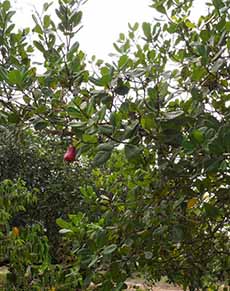Lowfat PB2 Cashew Powder & The History Of Cashews
|
|
Way back in 2008, we wrote about the introduction of PB2, an aromatic and tasty peanut powder made from ground roasted peanuts that have been almost 85% defatted. People who love peanut butter but not the fat had a new friend in PB2. It could be reconstituted with water to a homemade PB-like consistency; but has equal uses as powdered garnish/flavoring and a cooking/baking ingredient. Our favorite uses are mixing with vanilla or plain yogurt, tossing into chocolate and vanilla milkshakes, adding to pancake batter, and mixing into softened vanilla ice cream to make peanut butter ice cream. Reconstituted with water as a peanut butter substitute, you won’t mistake PB2 for the real thing, any more than fat-free milk can be mistaken for whole milk. But it’s a nice peanut butter paste. And as a reconstituted spread, it was far superior in taste than other peanut butter substitutes we’d tried. At 54 calories per 2 tablespoons and just 2.8g total fat, it saved calories and fat for those who can’t have one or both. And, it’s a replacement for protein powder in a smoothie, due to the similarity in the powder consistency. Now there’s an equivalent nut powder for cashew lovers: PB2’s powdered cashew butter. Like PB2 peanut butter, it’s a single-ingredient product: 100% all-natural cashews. Roasted cashews are pressed to remove most of the oil, and then blended into a fine powder. The first powdered cashew product of its kind, it’s 60 calories per two tablespoons, compared to 198 calories for regular cashew butter. With fewer calories and some 80% less fat, it’s protein packed, with 4 grams of plant-based protein per 13-gram serving, and only 2.5 grams of fat. For a nut butter spread, just blend 2 tablespoons of PB2 Cashew Powder with 1 tablespoon of water and stir until smooth. Next, bake with it, or mix it into foods and drinks. All PB2 products are: PB2 Cashew Powder is available on Amazon and other e-tailers, and at these retailers near you. DISCOVER MORE AT PB2FOODS.COM. Portuguese travelers came across cashew nuts in northeastern Brazil in 1558. The nuts are the fruit of the cashew tree (Anacardium occidentale, photo #4) a tropical evergreen. But there was a catch. The seed (the edible nut portion) is surrounded by a shell and skin that contain an allergenic oil that’s a potent skin irritant, similar to poison ivy. Because of the irritation, the Portuguese thought the nuts were inedible. But the indigenous Tupi people showed them that it was the shell and skin, and not the seeds, that were irritating. They shared how to roast the cashews to remove the irritants. The word cashew comes from the Tupi word acaju, their generic word for nut. The Tupi themselves learned to eat cashews from capuchin monkeys. The primates use primitive tools to break the shells and pick out the nuts [source]. That’s why cashews are are the only nut sold solely unshelled! From Brazil, Portuguese merchants brought cashews to Goa on the southwestern coast of India, about 1560. It then spread through India. In the second half of the 16th century, cashews spread to Southeast Asia and Africa. Much later it reached the U.S., around 1905. Cashews reached the U.S. around 1905. The nuts didn’t become popular in the the western world until the mid-1920s, when the General Foods Corporation began shipping them in quantity to the U.S. and Europe. In 2019, four million tonnes* of cashew nuts were produced globally, with Ivory Coast and India as the leading producers. Brazil, Vietnam and regions of West Africa are also major producers. |
|
|
________________ *Both ton and tonne are units of weight, but are not the same. A ton is a British and American measure, while a tonne is a metric measure.
|
||




